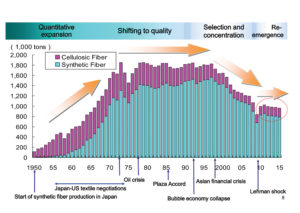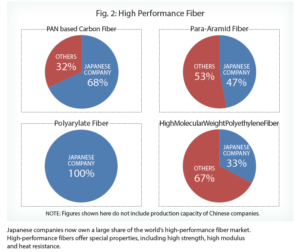On the future of Japanese high-performance and high-function fibers.

IFAI Japan, in collaboration with IFAI, conducted a Japan Technical Seminar at IFAI Expo 2016 in Charlotte, N.C., to introduce new technologies and ideas. The Japan Chemical Fibers Association (JCFA), which consists of members of world-leading chemical fiber manufacturers (including Teijin Ltd., Toray Industries, Kuraray, Co. Ltd., Toyobo, Asahi Kasei Corp., Unitika Ltd., Mitsubishi Rayon Co. Ltd., Kaneka Corp. and others) sponsored one presentation. Mr. Hiroya Kagiyama, senior manager of the business affairs and research group at the JCFA, and Mr. Tamon Akiba, manager of the corporate strategic planning division of Toray Industries, gave a presentation on “The future of Japanese high-performance/high-functional fibers.”
A brief history
Figure 1 shows a history of Japanese chemical fiber production. The chemical fiber industry demonstrated high economic growth from the middle of the 1950s through the 1960s, as a leading industry. But over the past 20 years, production in Japan has continued to decrease, due in large part to international competition. Especially with regard to commodity products, there is growing concern about serious over-supply due to capacity expansion by emerging economies in the Asian region.
Under these circumstances, Japanese chemical fiber companies had to restructure themselves through selection and concentration, and worked to develop new technologies and to supply value-added products. As a result, the Japanese chemical fibers industry is maintaining a competitive edge in the area of high-performance and high-function fibers.
High-performance fibers
 As seen in Figure 2 (page 69), Japanese companies now have a large share of the world’s high-performance fiber market. These fibers offer special performance properties, including high strength, high modulus and/or heat resistance.
As seen in Figure 2 (page 69), Japanese companies now have a large share of the world’s high-performance fiber market. These fibers offer special performance properties, including high strength, high modulus and/or heat resistance.
A number of high-performance fibers were introduced.
• Teijin has a production of aramid fibers, as does Toray through a joint venture with DuPont. Aramid fiber has para- and meta-series versions; para-aramid is characterized by high strength and meta-aramid features flame retardancy.
• Toray, Teijin and Mitsubishi Rayon hold 70 percent of the world market for carbon fiber, which offers excellent strength and a light weight.
• Vectran™ polyarylate, a high-performance multifilament yarn spun from liquid crystal polymer (LCP) from Kuraray, offers high strength, low moisture absorption and superior abrasion resistance. The raw fiber can be dyed.
• The polybenzoxazole (PBO) fiber Zylon® from Toyobo (currently the only producer in the world of PBO fiber) is said to be the world’s strongest fiber, with high flame resistance, extremely high tensile strength and excellent thermal properties.
• Kuraray’s Kuralon™ is a fiber made from poval resin and displays high tenacity, low elongation, hydrophilic properties, weather resistance and alkali resistance.
• Polyetherimide (PEI) fiber, named Kurakiss™, also from Kuraray, is an amorphous thermoplastic resin featuring high heat resistance and low-smoke flame retardancy.
High-function fibers
High-function fibers, with special properties such as moisture absorbency and heat generation, are added to commodity fibers such as polyester. Several of these fibers recently developed by Japanese companies were introduced during the JCFA presentation at IFAI Expo.
• Raffinan by Teijin Frontier, termed “wearing cosmetics,” is used in women’s underwear to keep skin moisturized and maintain a healthy pH balance. It’s categorized as a cosmetic, is approved by the Health and Welfare Ministry of Japan and has started sales domestically.
• Exceval™ is Kuraray’s original PVA polymer which has the unique ability to dissolve in hot water. By mixing Exceval with different kind of polymers, very thin fibers or unique sectional fibers can be made.
• Breathair® from Toyobo is a 3-D spring structure cushioning material, featuring moderate resilience, excellent recoverability and superior pressure distribution.
Mitsubishi Rayon has developed a number of new high-function fibers. Vonnel is an acrylic fiber for industrial use, superior in light resistance and in acid and alkali resistance, hydrophilic and lipophilic. CoreBrid is a static-electricity-free and solar-heat-generation fiber, said to be the first and only core-in-sheath acrylic staple fiber in the world. By kneading carbon-compounded additives into the core, CoreBrid offers high electro-conductivity and heat-generation capabilities. Vonnel Ag is an acrylic fiber with bacteriostatic properties, added by kneading in a silver-based additive, authorized by the FDA and the EPA.
“Smartification”
Recently, the Japanese chemical fiber industry has been focusing on incorporating IoT (Internet of Things) technologies and “smartification” into fiber products to meet the state-of-the-art demands being made of chemical fibers and the fabrics and products they comprise. Comfort, communication and connectivity are key.
Toray Industries and NTT communications, a Japanese IT company, have jointly developed a smart textile called hitoe™, a bio-electrode conductive fiber consisting of nanofiber knit impregnated with conductive polymers (polymeric compounds that conduct electricity). When worn, hitoe senses heart rate and acceleration data, which is sent to a computer via Bluetooth®. Toray started a “worker’s health monitoring service” in August 2016; the company can monitor workers’ health data on computers in real time by using hitoe. If any employee has any health troubles (such as dehydration) while working, it can be found immediately.
Cocomi™ is a stretchable conductive film-like material for the smart sensing wear developed by Toyobo. Due to its low impedance, elasticity and thinness, it offers the natural wear comfort and accurate measurement of biological data from the human body.
The world’s first elastic electrical wire using fiber technology was developed by Asahi Kasei Corp. Roboden™ consists of coiled copper wire covered with elastic fiber; it can be stretched by 40 percent. By using copper wire, it achieves lower electric resistance than conductive elastic fibers, as well as a long lifespan and excellent resistance to disconnection. Roboden eliminates excess slack at points where wires are bent, reduced tangling, snaggling and pinching as well as time and labor for wiring designs with easy maintenance. It’s used, for example, for the wire of robot arms, which moves flexibly and whose length changes frequently.
Teijin has created PaperBeacon, the first sheet-type beacon that authorizes network connections, through smartphones or tablet devices. The system is enabled by Teijin’s material technologies in the two-dimensional communication sheet Cell Form™. Used in combination with Tagcast, a tag-casting beacon technology from Tagcast Inc., PaperBeacon can identify a specific place (such as a table) that conventional beacons cannot. Users can get authorized and connect to the local area network just by putting a smartphone on it.
Friendlier fibers
Global climate change is also an important concern to be addressed in the future, and fiber producers are playing their part.
Terramac™ from Unitika is a bio-based environmentally friendly fiber using polylactic acid (PLA) main ingredients that incorporate annually renewable resources such as corn. Because Terramac is biodegradable through micro-organisms in the soil, it is attracting attention as a plastic material with low environmental load. PLA anti-weed sheets and sandbags are not only eco-friendly—they also don’t need to be removed after use because they degrade biologically.
Toray has developed fully bio-based PET (polyethylene terephthalate), made from two raw materials, paraxylene (PX) and monoethylene glycol (MEG). The company had already launched the business of partially bio-based PET, made from petro-based PX and bio-based MEG. Toray has now started pilot production of fully bio-based PET; it has the same properties as petro-based PET, and its film and fiber can be made by the same facilities. It is expected to be available for industrial use by 2020.
Mr. Hiroya Kagiygama, Japan Chemical Fibers Association, comments, “Not only providing good quality products, we are also seeking to provide solutions to customers to meet a variety of their needs.” The group is working to cultivate new demand in new business fields and markets.
 TEXTILES.ORG
TEXTILES.ORG


